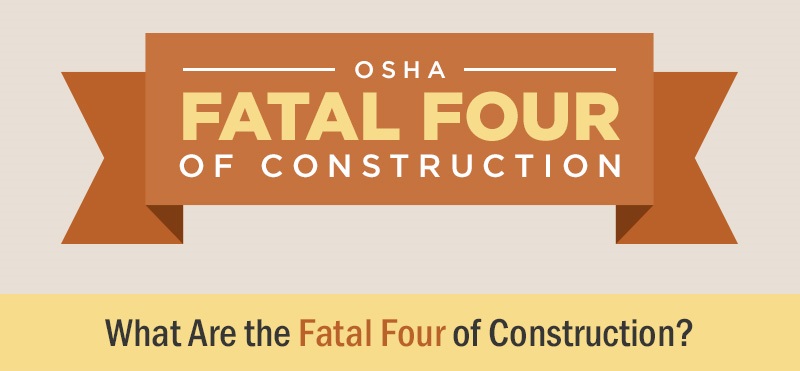

The term “fatal four” refers to the four types of hazards most common on construction worksites. These hazards account for almost 60% of all deaths that occur during construction. Recognizing and understanding these hazards can greatly reduce a worker’s chances of being seriously injured or killed by one of them. The fatal four are:
- Fall hazards: Workers can fall from high elevations, such as the framework of a building; or from objects, such as ladders and scaffolding; and even from the ground down into pits and trenches dug in the earth.
- Caught-between hazards: When a person is pinned on or between two or more objects, accidents can be quick and gruesome. For example, someone who becomes trapped between a piece of equipment and a wall is in a caught-between hazard.
- Struck-by hazards: Construction sites have a lot of debris and equipment moving around. Being struck by a falling tool, piece of building material, or a machine can cause serious injuries and death, even when a worker is wearing protection.
- Electrocution hazards: Electrical shocks cannot be seen as easily as some other dangers. Everyone at a construction site needs to know when electrical cables are live. Shocks can also occur when equipment or power tools are not properly maintained and have frayed or exposed wires, so they need to be checked before each use as well.
Each of these hazards is made common by the very nature of construction work. Slip-and-falls, in general, are the most common accidents just about anywhere! Debris and tools at a construction site make tripping and falling even easier, and since a lot of work is done on ladders, scaffolding, and raised areas, falls are much more serious.
Similarly, with so much equipment and so many people moving about a worksite, being struck by a machine or falling object can happen in the blink of an eye. Being pinned between two machines, or crushed between building materials and a wall, is all too easy. Since electrical work is often being done at construction sites, workers have a much higher chance of coming into contact with exposed wiring. If workers are not warned about when the power is coming on, a wire that was safe can become lethal.
Different ways to share this infographic:
- Embed the infographic by copying and pasting the following code onto your website:
<div align=”center”><a href=”https://www.wrshlaw.com/blog/construction-accident/facts-on-the-fatal-four/” target=”_blank”><img src=”https://www.wrshlaw.com/images/construction-accidents-infographic-thumb.jpg” alt=”Construction Accidents” width=”612″ border=”0″ class=”imgcenter” /></a> <p align=”center”><a href=”https://www.wrshlaw.com/images/construction-accidents-infographic.jpg” target=”_blank”>See Larger Image</a></div> - Link to this page on your own website or blog:
<a href=”https://www.wrshlaw.com/blog/construction-accident/facts-on-the-fatal-four/”>WRSH Presents: Fatal Four Construction Accidents Infographic</a> - Write a blog post about the infographic.
- Share this page and infographic on your social media profile.
Avoiding the Fatal Four
Mostly, accidents involving the fatal four come from carelessness or a lack of proper training. Too often, employers become comfortable with the dangerous conditions on a construction site and fail to appreciate just how easy it is for a deadly accident to occur. After spending hundreds of hours using a massive crane or working with jackhammers, it can be easy to forget that these machines are quite dangerous. When this happens, they stop taking every safety precaution and start cutting corners to get the job done faster.
Such a mistake not only puts the workers’ lives in danger, but also the lives of those around the site.
Using proper equipment, including ropes, can help prevent falls, as can making sure ladders and scaffolding are well-maintained and replaced when necessary. Struck-by hazards can be avoided by each worker being aware of his surroundings, watching out for equipment at his feet or falling objects above. Supervisors and workers should watch out for each other when using machines, especially when moving heavy loads, to avoid getting anyone caught or stuck between objects. Employers must make sure that everyone at a worksite knows about electrical dangers, and power tools need to be maintained and replaced when wires start to show.
Avoiding these fatal hazards really comes down to employers using common sense and following the regulations of the Occupational Safety and Health Administration (OSHA). Employers are required to post safety information for workers and to make sure their workers understand how to properly handle materials and remain safe at a construction site. These requirements are not always met, however.
At Wingate, Russotti, Shapiro, Moses & Halperin, LLP, we know construction accidents. We have great respect for the men and women who risk their lives every day at construction sites. When they’re hurt by an employer’s negligence, that’s unacceptable, and we do everything in our power to get them compensation. Call (212) 986- 7353 for a free consultation with a New York construction accident attorney.
